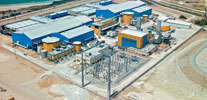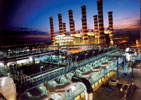
VWS Envig, as part of the global Veolia Water Solutions and Technologies group, is able to draw on the worldwide expertise and knowledge resources that the group has to offer. This extends to applications, industries, technologies and processes, most notably desalination.
According to Francois Gouws, director, Design and Build Projects, VWS Envig, desalination endeavours are growing in popularity due to a number of issues, especially climate change.
"From producing potable water for communities in arid or drought stricken areas, to using desalination in industry to save on municipal supplies, the demand for this process is increasing on a global scale."
Active in the desalination market worldwide, Veolia Water Solutions & Technologies has completed a significant number of projects using both thermal desalination and reverse osmosis technology. These plants range from small to the largest in the world. The group's most recently completed project is the Ashkelon Seawater Desalination Plant, south of Tel Aviv, Israel. The plant has a daily production capacity of 320 000 m³ of drinking water. This makes it the world's largest desalination plant using reverse osmosis technology.

Sidem, a wholly owned subsidiary of Veolia Water Solutions & Technologies, was recently awarded a project to design and construct the largest desalination plant in Saudi Arabia. The construction of the plant forms part of a larger independent water and power production project. The plant, which will be completed by 2010, will have a capacity of 800 000 m³ per day and will employ the multiple effect distillation (MED) thermal process. The MED process will recover heat from the project's power plant and use it to evaporate seawater at a relatively low temperature. Therefore, the electrical consumption is low, only a third of the energy consumed by competing technologies, making it an efficient method of desalinating seawater. Sidem will supply 27 desalination units and a remineralisation plant for this project.

In Australia, a continent hit by drought, Veolia has been awarded two significant desalination projects. The first is for a seawater reverse osmosis desalination plant in Sydney with a capacity of 250 000 m#179; per day. The contract is for the complete design, construction, operation and maintenance of the plant. The plant will comprise intake and outlet tunnels, a seawater pump station, pre-treatment filters, two pass reverse osmosis trains, post-treatment and a 40 000 m³ reservoir. While the initial capacity of the plant will be 250 000 m³ per day, the seawater intake and brine discharge tunnels are being designed to accommodate future expansions.
The second Australian project includes the design, construction and operation of a 125 000 m³ per day capacity desalination plant in the State of Queensland. This reverse osmosis plant will serve a population of approximately 450 000 residents and will begin operation in 2008.
In Europe, Veolia Water won a contract to design, build, operate, and maintain a similar plant in southern Spain. The contract forms part of a larger national desalination plant programme launched by the Spanish Ministry for the Environment. The contract also includes a 15-year operational contract. The total contract volume is estimated to be 78 million Euros.
Gouws notes that the expertise within the group, especially in this specialised field, places the local subsidiary in a favourable position to capitalise on the need for desalination projects in Africa. "Being part of a group like Veolia has many advantages. The tremendous resources and experience at our disposal ensure that we are able to offer clients turnkey solutions that are tailored to their requirements. This specialised knowledge, advice and assistance, combined with our local engineers' expertise and service capability, provides an excellent platform from which to launch local desalination projects."
For more information contact Francois Gouws, VWS Envig, +27 (0)11 663 3600, [email protected], www.veoliawater.com

© Technews Publishing (Pty) Ltd | All Rights Reserved